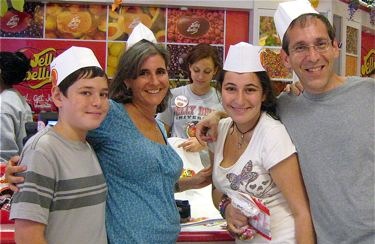 It is Friday afternoon and the Tel Aviv Port is hopping. The lounge chairs at the beach-front restaurants and pubs are packed as patrons fill up on seafood and down decadently prepared cocktails and imported beer.
It is Friday afternoon and the Tel Aviv Port is hopping. The lounge chairs at the beach-front restaurants and pubs are packed as patrons fill up on seafood and down decadently prepared cocktails and imported beer.
Joggers, roller-bladers and cycling enthusiasts whip around the curved wooden plaza, fashioned after the waves of the water below, anticipating the soon-to-be-setting Mediterranean sun and the dampening of the ever oppressive summer heat.
And there, in the middle of secular Tel Aviv at its finest, is what might at first seem entirely anomalous, but on further inspection makes eminent sense: a mass Kabbalat Shabbat (welcoming the Sabbath) service, with more than 1,000 attendees, most bareheaded, reciting verse by Israel’s national poet Hayim Bialik, and singing along to a mix of traditional tunes and songs written especially for this most unusual of congregations.
Welcome to the new secular, spiritual Israel spontaneously erupting throughout the country, from the shores of Tel Aviv to kibbutzim in the Galilee to the egalitarian mix that can be found in the more progressive parts of Jerusalem.
While each of these transdenominational, often boldly secular, congregations started as separate initiatives, 40 have now organized into a non-profit association created to spark dialogue and support in both fledgling and established groups. What they have in common, says Itamar Lapid, the head of the Israeli Network of Emergent Communities, which was founded in 2009, is that “we don’t believe Jewish identity should be outsourced. You shouldn’t be a ‘customer’ of Judaism. You need to take responsibility over your own Jewish life.â€
That philosophy represents a radical departure from the approach of the Reform, Conservative and other organized movements, which have tried for years to gain a foothold in Israel… and mostly failed to make a blip on the national canvas. Lapid tells The Jerusalem Report that these US-imported organizations “put too much effort into legislation and advocacy.â€
Change will only come from the ground up, he contends, and top-down approaches, where non-Orthodox ordained rabbis are essentially parachuted into localities, won’t succeed, despite recent wins at the High Court enabling these groups to receive state funding.
Last summer’s social justice protest movement is an example of the sort of grass-roots uprising that Lapid believes has the potential to change the country’s dialogue: not just for lower cottage cheese prices and rents, but as a chance to reclaim the nearly forgotten – and, in his opinion, dearly needed – concept of “community.â€
Israel Sykes, who was recently hired as an organizational consultant for Lapid’s network, says that one of the most extraordinary aspects of the social protest movement was the explosion of community that took place in the tent camps.
“People discovered one another; they discovered it was possible to be in a setting where people could really talk; where they could take control over creating their own reality,†he tells The Report. “That was the core theme that I saw – that people are yearning for community.â€
Eran Baruch, executive director of the non-Orthodox educational association, BINA , which is perhaps best known for running a “secular yeshiva†in Tel Aviv, agrees. He describes Israeli society in terms of three evolutions. “The first generation rebelled against their parents, but they still knew their tradition.The second generation was all about establishing new settlements, setting up factories and consolidating the army. But we’re no longer so busy building kibbutzim in the Galilee. So, now, the third generation is missing something. The Israeli ethos of the Palmach, the Six- Day War and Moshe Dayan is no longer deep enough for them.â€
“If you look back to the 1950s, it was all about loyalty to the state,†Lapid adds. “Then, in the ’80s and ’90s, privatization took hold, not just in the economic sense, but in the social sphere as well. The pendulum went from one extreme to the other.â€
Sykes puts it more bleakly: “Israel changed from being an inclusive friendly place, where you bring over a cake to a new neighbor, to one that is much more Western and alienated.â€
While the new non-traditional and secular congregations are coming into their own now, they have actually been around for more than a decade. The first were established primarily in the north of the country, due in large part to the kibbutz movement-sponsored Midreshet Oranim, an educational institution that promotes non-Orthodox approaches to Jewish learning. The first congregation set up was called Nigun HaLev, situated on Kibbutz Nahalal in the Jezreel Valley.
Nigun HaLev (the name means Song of the Heart) holds Kabbalat Shabbat services every week, runs a beit midrash (study hall), conducts workshops on social justice, and creates its own life-cycle ceremonies for bar and bat mitzva-aged children. Ironically, the congregation benefits from the very privatization of the kibbutz movement decried by Lapid: When the community’s dining hall was closed down, space for alternative activities became available.
Other congregations, like the one at Moshav Shimshit, weren’t so ‘lucky,’ and services are still held primarily in people’s homes. Whether established or emerging, all of the congregations in the Network say they are open to anyone – secular or religious – seeking to reconnect with his or her Jewish heritage. Some people wear head coverings, some don’t. Some pray with words, others meditate.
“We’re not asking anyone what their beliefs are when they come in the door,†says Esteban Gottfried, the Argentinianborn founder of Beit Tefilah Israeli (literally, The House of Israeli Prayer), the congregation that holds the mass Kabbalat Shabbat at the Tel Aviv port. Just don’t call them atheists. “We’re looking at something that’s beyond secular,†he emphasizes.
Beit Tefila Israeli has honed its services to a uniquely Israeli mix. Gottfried describes the community’s custom-made prayer book. “For every page of the traditional text, there is a facing page with contemporary Hebrew literature, speaking the same language of the prayers and asking the same questions,†he explains.
There are songs and poetry from classic Israeli artists, such as Naomi Shemer, Ehud Manor, Matti Caspi and Arik Einstein. There is even a Hebrew version of the Louis Armstrong standard, What a Wonderful World. The prayerbook is now used in eight of the new communities.
Some of the melodies at Beit Tefila Israeli stick to the tried and true, but there are also original compositions from contemporary Israeli performers, including Shlomo Gronich and Yoni Rechter, who occasionally attend services as well. “We are creating something that is specifically tailored for Israeli Judaism,†Gottfried emphasizes.
Among the 40 members of the Israeli Network of Emergent Communities, there are congregations from Metula at the very tip of the Galilee, to Ashdod and Gan Yavne south of Tel Aviv, and even as far south as Hatzerim in the northern Negev desert.
The interplay between the new non-traditional congregations and the spontaneous communities that emerged on Tel Aviv’s Rothschild Boulevard a year ago is still being worked out.
Both BINA and Beit Tefilah Israeli organized Friday night services, as well as Megillah readings on the fast day of Tisha B’av, for example. But, laments BINA ’s Baruch, “in most cases we failed. The leadership wasn’t speaking a Jewish language at all.â€
He points to the evening of the final social protest demonstration, which drew some 400,000 people to the streets across the country. “The portion of the week was Mishpatim from the Book of Deuteronomy, which starts with the line, tzedek, tzedek, tirdof [justice, justice you will pursue]. It was a perfect opportunity.
But no one said it on stage.â€
The point is well taken: To truly make an impact, the new secular congregations will have to move beyond their own mostly limited and, at times, insular communities. Beit Tefilah Israeli and BINA both run seminars in the army, often together. Beit Tefilah Israeli’s Gottfried has been involved in 20 such workshops in the last year and a half, which he says have exposed more than 3,000 soldiers to a non-Orthodox perspective on Jewish ritual. Baruch says BINA reaches some 8,500 in the IDF every year.
Baruch has a more immediate concern.
“My daughter is in the army,†he says, “and during her time there, she’ll have maybe seven seminars on Judaism. In six of those she’ll be facing an Orthodox rabbi where the message will be that Judaism belongs to the Orthodox.†Baruch’s goal is plain. “If you’re asked to say something about the Portion of the Week on Shabbat, don’t just call on an Orthodox soldier. You too can say something.â€
When these soldiers leave the army, the hope is that they will seek out a means to further even the earliest stirrings of Jewish expression in a way that is more pluralistic and egalitarian. That will in turn feed the next generation of Israel’s emerging secular congregations.
Will it make an impact? Baruch remains upbeat. “This is not something you build in a day,†he says. Gottfried echoes the sentiment. “It’s a process. It takes years or decades to do it.â€
Ultimately, the question may be phrased backward. “When people ask what will be the impact our communities have on Israeli society, that question assumes a top down structure,†says Rabbi Ruth Gan Kagan, founder of Jerusalem’s Nava Tehila’s congregation (see sidebar below). “The more important question is the impact that Israeli society is having on the spontaneous creation of these new prayer communities.â€
Sidebar: “A spiritual mosh pit”
Six p.m. on a Friday and up the hill from Tel Aviv, the musicians at Nava Tehila in Jerusalem are warming up the crowd with a wordless niggun (melody) to welcome Shabbat. The rented space – ironically downstairs from a Reform congregation – can only hold 200; more than 300 regularly show up. That’s fine for most who can be found dancing in the congregation’s spiritual mosh pit.
Chairs are set up in a circle with the musicians in the middle. The result, despite the lack of a sunset on the beach is, if anything, even more ecstatic; neo-Hassidic in its way, albeit with guitar, darbuka drums, cello, harp, violin, flute and the occasional didgeridoo. Middle- eastern, Flamenco and reggae riffs pepper the music, as does a polka, used as one of the melodies for the traditional Lekha Dodi prayer. All of the music is original, written by the musicians themselves.
Instead of singing an entire prayer (or replacing it with a modern Hebrew equivalent), Nava Tehila employs a style the congregation’s Israeli-born founder, Rabbi Ruth Gan Kagan, refers to as “chanting.†In it, a single line or two is taken from each psalm and repeated over and over as the music builds in intensity. The result is a service that works on multiple levels, appealing to both the more traditionally minded and those who don’t (or don’t want to) understand the words but still enjoy the communal singing.
“Sometimes it’s better to do a little bit with kavana (intention) than doing a lot where it doesn’t inspire you,” says Kagan.
This article was originally commissioned by The Jerusalem Report and appeared here.

